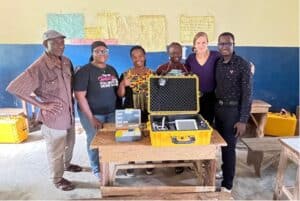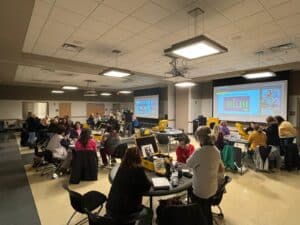Projects
Appalachian STAR Trial: Specialty Telemedicine Access for Referrals
This project represents a collaboration between the Center for Hearing Health Access, the University of Kentucky, the Kentucky Office for Children with Special Healthcare Needs (OCSHN), Kentucky Center for Statistics (KYSTATS), Kentucky Cabinet for Health and Family Services, and Kentucky Department of Education. The trial evaluates a multilevel intervention (STAR model) that combines an enhanced school hearing screening protocol with telemedicine referral for specialty care access in rural Kentucky schools. This model builds upon a previous trial we conducted in rural Alaska, in which telemedicine-based specialty referral improved both proportion of children receiving follow-up and time to follow-up. The adapted STAR model will utilize an enhanced mHealth screening protocol that includes tympanometry for the detection of middle ear disease. The STAR model will also deploy a school-based specialty telemedicine referral process for children who refer school screening. Using a hybrid effectiveness-implementation trial design, we will measure the effectiveness of the model and implementation factors to inform future scale-up.
For more information, see: https://clinicaltrials.gov/ct2/show/NCT05513833
North STAR Trial: Specialty Telemedicine Access for Referrals in Rural Alaska
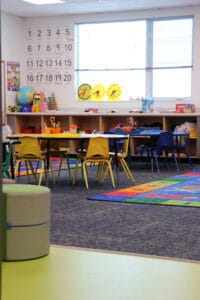 This project represents a collaboration between the Center for Hearing Health Access, Southcentral Foundation, Alaska Department of Health and Social Services, and Alaska Department of Education. The North STAR Trial is evaluating a multilevel intervention (STAR model) that combines an enhanced school hearing screening protocol with telemedicine referral for specialty care access in three rural Alaskan regions. This model builds upon a previous trial we conducted in the tribal health system in rural northwest Alaska, now bringing telemedicine technology directly into schools and expanding implementation to also include non-tribal healthcare. All children in this trial will receive an enhanced school hearing screening that tests hearing capability and middle ear health. If children are referred for follow-up from the school hearing screening, schools will use telemedicine to facilitate follow-up with specialty providers. The North STAR trial will utilize a hybrid implementation-effectiveness design to measure the effectiveness and the implementation of the model, to inform future scale-up. For more information, see: https://reporter.nih.gov/project-details/10490362
This project represents a collaboration between the Center for Hearing Health Access, Southcentral Foundation, Alaska Department of Health and Social Services, and Alaska Department of Education. The North STAR Trial is evaluating a multilevel intervention (STAR model) that combines an enhanced school hearing screening protocol with telemedicine referral for specialty care access in three rural Alaskan regions. This model builds upon a previous trial we conducted in the tribal health system in rural northwest Alaska, now bringing telemedicine technology directly into schools and expanding implementation to also include non-tribal healthcare. All children in this trial will receive an enhanced school hearing screening that tests hearing capability and middle ear health. If children are referred for follow-up from the school hearing screening, schools will use telemedicine to facilitate follow-up with specialty providers. The North STAR trial will utilize a hybrid implementation-effectiveness design to measure the effectiveness and the implementation of the model, to inform future scale-up. For more information, see: https://reporter.nih.gov/project-details/10490362
HEAR-Arkansas: Bringing Hearing Health to Rural Arkansas
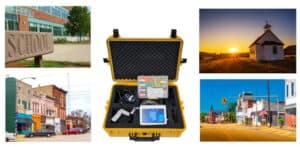 Hearing Evaluation, Advocacy and Research (HEAR) uses technologic innovation to increase access to specialty care within the patient’s hometown. With pilot funds from the University of Mississippi Medical Center Telehealth Center of Excellence, and in partnership with the Faith-Academic Initiatives for Transforming Health (FAITH) Network, the Center for Hearing Health Access will pilot HEAR-Arkansas in one rural county in the Arkansas Delta.
Hearing Evaluation, Advocacy and Research (HEAR) uses technologic innovation to increase access to specialty care within the patient’s hometown. With pilot funds from the University of Mississippi Medical Center Telehealth Center of Excellence, and in partnership with the Faith-Academic Initiatives for Transforming Health (FAITH) Network, the Center for Hearing Health Access will pilot HEAR-Arkansas in one rural county in the Arkansas Delta.
Multifactorial Determinants of Childhood Hearing Loss in Rural Alaska
 This project is a collaboration between the Center for Hearing Health Access, Norton Sound Health Corporation, and Southcentral Foundation. This cohort study evaluates the impact of environmental, nutritional, and genetic risk factors on childhood hearing loss in rural Alaskan children one to four years of age. Factors evaluated include lack of running water, wood-burning stove exposure, household crowding, breastfeeding, and CPT1A artic variant (a single nucleotide variant in carnitine palmitoyltransferase 1A (CPT1A) gene, which is required for fatty acid metabolism and confers increased susceptibility to infections). https://reporter.nih.gov/search/fLz0MOKMXECzG5AQ6G9rPg/project-details/10606759
This project is a collaboration between the Center for Hearing Health Access, Norton Sound Health Corporation, and Southcentral Foundation. This cohort study evaluates the impact of environmental, nutritional, and genetic risk factors on childhood hearing loss in rural Alaskan children one to four years of age. Factors evaluated include lack of running water, wood-burning stove exposure, household crowding, breastfeeding, and CPT1A artic variant (a single nucleotide variant in carnitine palmitoyltransferase 1A (CPT1A) gene, which is required for fatty acid metabolism and confers increased susceptibility to infections). https://reporter.nih.gov/search/fLz0MOKMXECzG5AQ6G9rPg/project-details/10606759
mHealth Tympanometer: A Digital Innovation to Address Preventable Childhood Hearing Loss
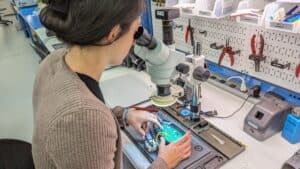 Preventable infection-related hearing loss is most prevalent in rural and underserved regions of the world, yet hearing screening is not universally implemented. Even when screening is in place, often it does not include tympanometry, an objective measure for middle ear health. This is predominately due to barriers related to cost and the need for highly trained professions to use a tympanometer. To address this gap in screening capabilities, we have been awarded grant funding to develop and validate a low-cost smartphone tympanometer with machine learning interpretation in collaboration with Duke University biomedical engineering, the University of Pretoria, and our industry partner, hearX. We are conducting a first-in-human pilot study to provide initial insights into design and functionality of the device at UAMS and Arkansas Children’s before performing the larger clinical performance study in South Africa to pave the way forward for future commercialization of the device. With large-scale implementation of this ground-breaking technology, the landscape of childhood hearing loss can be transformed to positively impact children and underserved communities across the US and abroad. For more information, see: https://reporter.nih.gov/project-details/10844675
Preventable infection-related hearing loss is most prevalent in rural and underserved regions of the world, yet hearing screening is not universally implemented. Even when screening is in place, often it does not include tympanometry, an objective measure for middle ear health. This is predominately due to barriers related to cost and the need for highly trained professions to use a tympanometer. To address this gap in screening capabilities, we have been awarded grant funding to develop and validate a low-cost smartphone tympanometer with machine learning interpretation in collaboration with Duke University biomedical engineering, the University of Pretoria, and our industry partner, hearX. We are conducting a first-in-human pilot study to provide initial insights into design and functionality of the device at UAMS and Arkansas Children’s before performing the larger clinical performance study in South Africa to pave the way forward for future commercialization of the device. With large-scale implementation of this ground-breaking technology, the landscape of childhood hearing loss can be transformed to positively impact children and underserved communities across the US and abroad. For more information, see: https://reporter.nih.gov/project-details/10844675
Addressing Childhood Hearing Loss in an Alaska Native Population: a Community Randomized Trial (“Hearing Norton Sound Trial”)
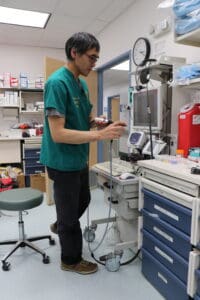 A collaboration between the Center for Hearing Health Access, Duke University, and Norton Sound Health Corporation, this mixed methods trial evaluated an enhanced school hearing protocol and a specialty telemedicine referral pathway for school hearing screening. The trial took place between 2017-2020 in 15 rural communities in the Bering Strait region of northwest Alaska. Key results were that children randomized to specialty telemedicine referral were 2.3x more likely to receive follow-up care, and follow-up occurred 17x faster, compared children randomized to the standard primary care referral pathway consisting of a letter home to families. This trial also established tympanometry as an essential tool for increasing school hearing screening outcomes in rural regions.
A collaboration between the Center for Hearing Health Access, Duke University, and Norton Sound Health Corporation, this mixed methods trial evaluated an enhanced school hearing protocol and a specialty telemedicine referral pathway for school hearing screening. The trial took place between 2017-2020 in 15 rural communities in the Bering Strait region of northwest Alaska. Key results were that children randomized to specialty telemedicine referral were 2.3x more likely to receive follow-up care, and follow-up occurred 17x faster, compared children randomized to the standard primary care referral pathway consisting of a letter home to families. This trial also established tympanometry as an essential tool for increasing school hearing screening outcomes in rural regions.
https://www.pcori.org/research-results/2016/identifying-and-treating-childhood-hearing-loss-rural-alaska-hearing-norton-sound-study
Integrating Hearing and Vision Screening for School Children in Sierra Leone
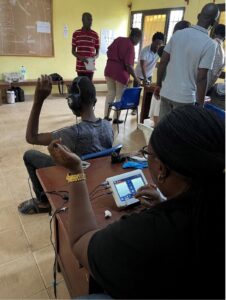 This project is a collaboration between the Center for Hearing Health Access, Queen’s University Belfast, Innovations for Poverty Action, and Vision Action to assess the feasibility of combining vision and hearing screening for primary school children in rural Sierra Leone. Timely identification and intervention for children with hearing loss and visual impairment is critical to maximize learning in the classroom; however, given the scarcity of trained providers, innovative low-cost models of care are needed to improve access in underserved regions of the world. The overarching goals for this project include evaluating the feasibility of integrating hearing and vision screening in rural primary schools, implementing low-cost treatment solutions, and understanding the impact of sensory impairment on academic performance.
This project is a collaboration between the Center for Hearing Health Access, Queen’s University Belfast, Innovations for Poverty Action, and Vision Action to assess the feasibility of combining vision and hearing screening for primary school children in rural Sierra Leone. Timely identification and intervention for children with hearing loss and visual impairment is critical to maximize learning in the classroom; however, given the scarcity of trained providers, innovative low-cost models of care are needed to improve access in underserved regions of the world. The overarching goals for this project include evaluating the feasibility of integrating hearing and vision screening in rural primary schools, implementing low-cost treatment solutions, and understanding the impact of sensory impairment on academic performance.